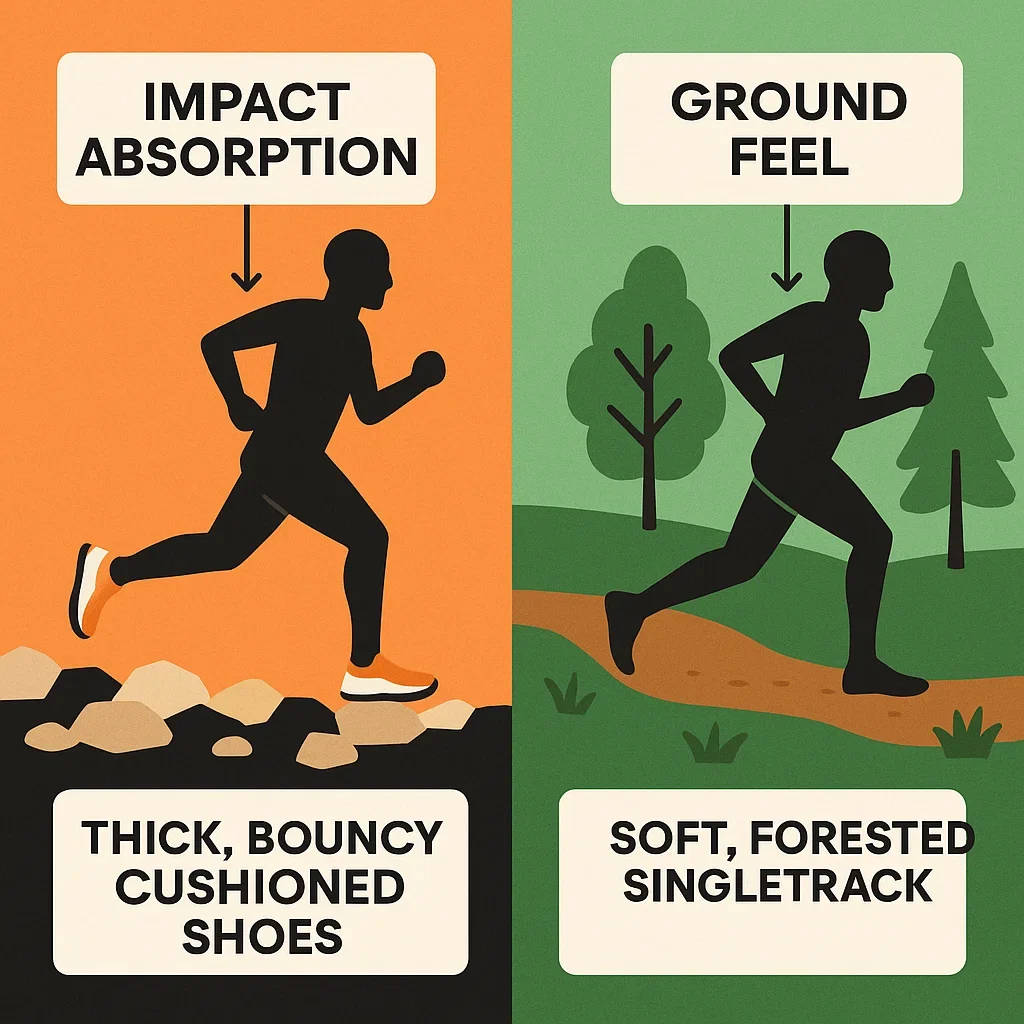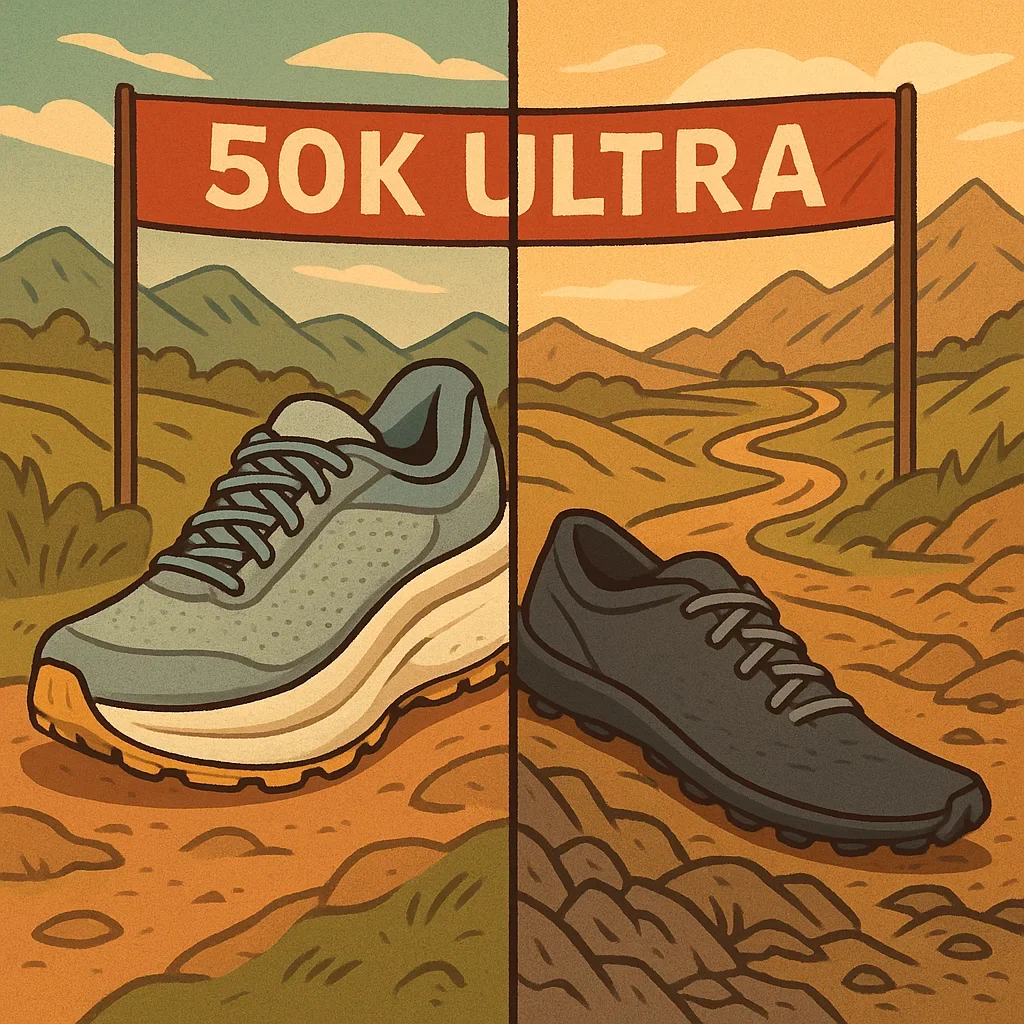Cushion vs Minimal: The ultimate 50K ultra marathon trail shoe debate!
Should you float above the rocks, or feel every root and ripple underfoot? Here’s the deep dive—features, pros, cons, decision tools, real runner stories, and more.
| Feature | Cushioned Shoe | Minimalist Shoe |
|---|---|---|
| Stack Height | 28–36mm (max) | 12–24mm (low) |
| Protection | Excellent (impact, rocks, fatigue) | Minimal (you feel terrain directly) |
| Weight | 280–340g | 180–260g |
| Ground Feel | Low | Maximum |
| Stability | High (for long ultras) | Agile, responsive |
| Best for | Runners needing protection on hard, rocky, or unknown courses | Experienced runners, soft or predictable terrain, natural stride fans |
- Reduces leg fatigue and joint impact on rocky/hard terrain
- More forgiving if your stride breaks down late in the race
- Best for injury-prone runners or those carrying extra weight
- Extra comfort in 6–9 hour 50Ks
- Superior ground feel—react quickly to terrain changes
- Lighter, more nimble, encourages natural foot mechanics
- Great for fast runners, soft/forgiving trails, technical agility
- Less “sloppy” in mud—fewer overlays to trap debris
- CUSHION if you’ve had stress injuries, expect rocky/hard ground, or are unsure of the course.
- MINIMAL if you’re experienced, love technical, softer singletrack, and have strong lower legs.
- TEST BOTH in training—don’t experiment on race day!
🥇 Top Cushioned & Minimalist Trail Shoes for 50K (2025)
| Model | Type | Stack/Drop | Weight | Best Use |
|---|---|---|---|---|
| Hoka Speedgoat 6 | Cushioned | 33mm/4mm | 286g | Rugged, long ultras, hardpack |
| Brooks Caldera 7 | Cushioned | 35mm/6mm | 278g | Mixed, wet, max comfort |
| Altra Lone Peak 8 | Minimal/Zero Drop | 25mm/0mm | 278g | Natural stride, wide foot, mixed terrain |
| Inov-8 Trailfly G 270 | Minimal | 22mm/0mm | 270g | Technical, agile, race speed |
| Merrell Skyfire 2 | Minimal | 21mm/6mm | 230g | Fast, short ultras, dry ground |
🗣️ Runner Stories: Cushion vs Minimal in the Real World
– Jason, trail runner, sub-7 hour 50K
– Kim, 50K ultra finisher
– Rafi, 50K top-10
⚡ Practical Tips for Choosing Between Cushion & Minimal Shoes
- Test on terrain: Cushion feels different on rocky vs soft trails—so does minimal! Try both types on real race-like ground.
- Mind your form: Minimal shoes reward strong, efficient stride; cushion can mask bad form late in races.
- Gradual adaptation: Never go from full-cushion to full-minimal overnight—transition over weeks to avoid injury.
- Consider race goals: Want speed? Try minimal. Want to finish strong, no matter the pace? Choose cushion.
- Bring both to race week: Weather/terrain changes may push you to swap—having a backup is smart!
| Runner | Experience | Shoe Type | Outcome | Takeaway |
|---|---|---|---|---|
| Jason | Intermediate | Minimal | Agile, but calf soreness | Adapt slowly to minimal |
| Kim | Beginner | Cushioned | No knee pain, steady finish | Cushion helps injury-prone |
| Rafi | Advanced | Minimal | Faster on technical, slower on fire road | Match shoe to course! |
❓ Frequently Asked Questions
🦶 Are minimalist shoes safe for everyone?
🦵 Do cushioned shoes prevent injuries?
⏱️ Which type is faster?
👟 Should I size up in both types for ultras?
📚 Further Reading
- iRunFar: Cushioned vs Minimalist Trail Shoes
- Runner’s World: Minimalist Running Shoes Guide
- Switchback Travel: Best Trail Running Shoes
Final Thoughts
There’s no single winner—just the right shoe for you, your feet, your goals, and your race. Experiment in training, adapt gradually, and don’t be afraid to mix things up. The only way to know your best 50K shoe is to run, learn, and evolve!

🏃♂️ In-Depth Runner Experiences: The Cushion vs Minimal Journey
– Helena, 4-time 50K finisher
– Pablo, 50K trail racer
– Dani, injury-prone ultra runner
– Vince, trail coach
| Runner Profile | Best With Cushion | Best With Minimal |
|---|---|---|
| Heavy or Injury-Prone | ✅ | |
| Speed Focused | ✅ | |
| Technical, Soft, or Variable Terrain | ✅ | |
| Long Duration (7h+) | ✅ | |
| Beginner Ultra Runner | ✅ | |
| Experienced, Strong Lower Legs | ✅ | |
| Prone to Foot Fatigue or Plantar Pain | ✅ | |
| Wants to Feel Every Trail Detail | ✅ |
⚠️ Common Mistakes & Pro Tips: Cushion vs Minimal for 50K
- Mistake: Jumping straight from maximal to minimal without months of adaptation. Tip: Transition slowly, build foot/leg strength.
- Mistake: Using the same model for every race, regardless of course. Tip: Analyze each 50K route—bring two pairs if weather is unpredictable.
- Mistake: Letting shoe marketing decide for you. Tip: Borrow, test, and rotate until you find YOUR sweet spot.
- Mistake: Ignoring warning signs—pain, numbness, blisters. Tip: Prioritize fit and comfort over trend or “expert” advice.
- Mistake: Not factoring in socks and insoles. Tip: Thicker socks work with minimal shoes; thin socks + plush cushion for hot races.

About the Author
Lost Pace is an ultramarathon runner, shoe-tester and the founder of umit.net. Based year-round in Türkiye’s rugged Kaçkar Mountains, he has logged 10,000 + km of technical trail running and completed multiple 50 K–100 K ultras.
Blending mountain grit with data, Lost analyses power (CP 300 W), HRV and nutrition to craft evidence-backed training plans. He has co-written 260 + long-form guides on footwear science, recovery and endurance nutrition, and is a regular beta-tester of AI-driven coaching tools.
When he isn’t chasing PRs or testing midsoles, you’ll find him sharing peer-reviewed research in plain English to help runners train smarter, stay healthier and finish stronger.
Ultrarunner · Data geek · Vegan athlete

